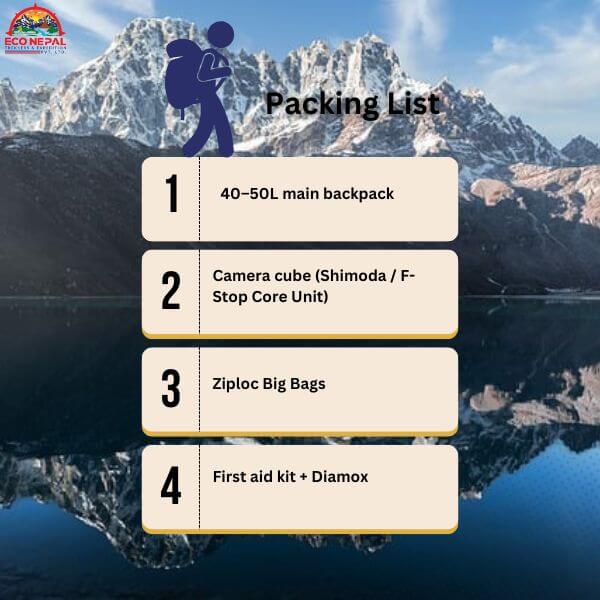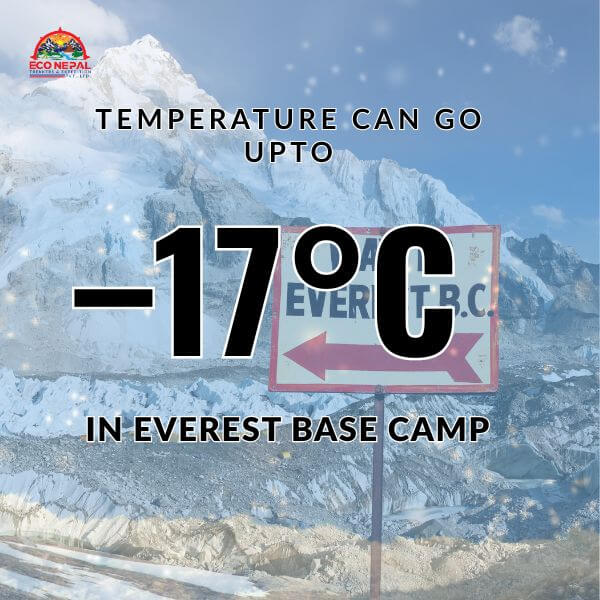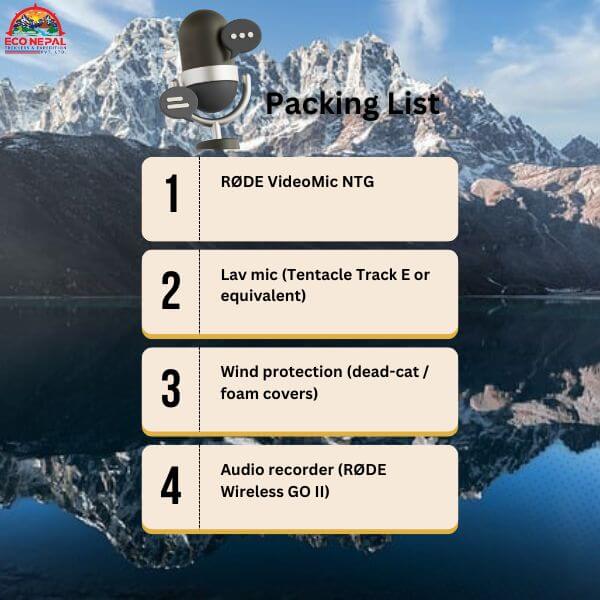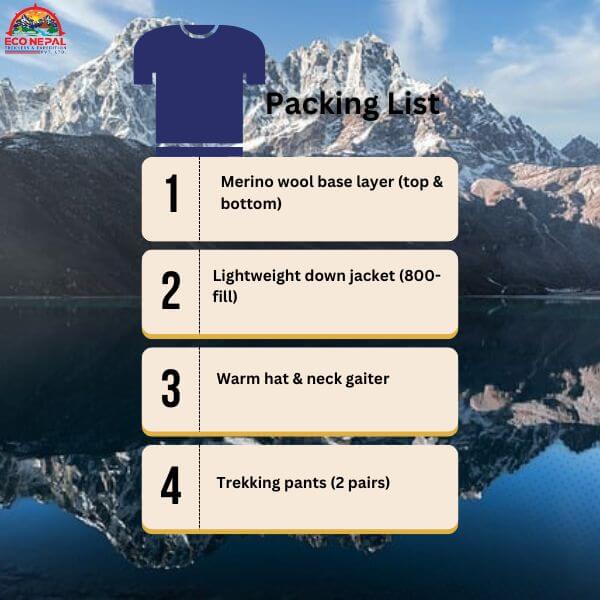Everest Base Camp trek packing for YouTube combines the list of great camera, good battery, decent storage and a great mic.
Quick Summary About Everest Base Camp Trek Packing For Youtube
- Filming at Everest Base Camp requires gear that can survive extreme cold, high winds, and limited charging options.
- YouTubers must pack differently than trekkers, prioritizing extra batteries, visual consistency, and backup equipment.
- Keeping your camera setup under 2.5 kg and avoiding heavy, unnecessary tools is key to lasting the full trek.
Let’s face it, everyone and their hiking boots are trying to film their Everest Base Camp trek these days. But here’s the secret: just showing up with a camera isn’t enough.
In recent times, YouTube has exploded with over 26,000 “EBC vlog” videos, and the numbers are still climbing. Furthermore, more than 80% of the vlog has a decent amount of views.
But here’s the thing, out of all those uploads, only a few actually look good. Most are shaky, noisy, dead battery, or just plain exhausting to watch.
So if you’re thinking, “I’ll just wing it and figure it out there,” think again.
This blog isn’t just another list. It’s a creator’s field guide, based on gear failures, weather truths, and real-world stories from people who made it (and some who barely did).
Let’s make sure your video doesn’t become another regret on Reddit.
Why Packing For Everest Base Camp As A YouTube Content Creator Is Totally Different
If you’re a trekker, you pack for comfort.
However, If you’re a YouTuber, you also need to pack for content.
That means your priorities flip. For example, instead of extra socks and multiple jackets, you might have to go for extra batteries and may be an extra go-pro.

In fact, most of the time you will be stuck between a need to stay warm or look consistent across footage.
Especially if you film intros one day and B-roll the next. Nobody wants to see the main character randomly change outfits halfway through.
And because there’s no “Take 2” at 5,000 meters, you need redundancy: two cameras, two mics, maybe even two tripods. One wrong move, one broken clip, and you lose that entire episode.
So we recommend you to pack light, but pack smart not just to survive, but to tell the story right as well.
What Filming At 5000m In Everest Actually Feels Like?
Now, let’s talk about the real weather and how it actually impacts your filmmaking journey.
I hope you already know every 1,000 meters you climb, it gets colder, windier, and harder to shoot.
At Lukla, things feel okay as the temperature is around 13°C during the day, maybe –2°C at night. But by the time you reach Everest Base Camp, it’s –17°C at night, and the wind feels like a slap.

And there is no denying the fact, Your batteries drain faster than your energy, and your mics? Well, most can’t even handle the gusts above 80 dB. Also, UV levels at altitude are brutal. They don’t just hurt your skin; they blow out your shots. Think blinding white snow, overexposed faces, and harsh shadows on every ridge.
In addition to that, there exists another problem of visibility. Due to which shooting in midday becomes extremely difficult. But hey, you can always shoot during early mornings or right before sunset; You can say that it’s a GOLDEN HOUR for shooting.
So deal with all of these problems here is a tip for you guys:
Keep your batteries warm. Let your camera adjust before you hit record (or you’ll get foggy lenses). And use ND filters or risk every shot looking like a washed-out postcard.
The environment doesn’t care about your SD card. But your audience will.
Which Camera Gear Might Be Better For Everest Base Camp?
Everyone wants crisp, cinematic footage at 5,000 meters. But let me say this upfront not every camera survives Everest.
The cold is your biggest enemy here. Most cameras lose battery life fast at –10°C, and those touchscreens you love? They freeze or lag when it matters most.
So what should you bring? Don’t worry we have got you covered. After talking to many trekkers who has ascended Everest Base Camp we have short-listed the camera that won’t give up on you even at times when climate isn’t in your favor.
| Camera | Why It’s Great |
| Olympus OM-1 | Small, weather-sealed, glove-friendly dials — perfect for creators who shoot a lot but don’t want dead weight. |
| Sony A7 IV | Full-frame power and gorgeous low light shots, but remember — it eats batteries, so bring 3–4. |
| GoPro Hero 13 | Full-frame power and gorgeous low light shots, but remember — it eats batteries, so bring 3–4. |
| Insta360 X3 | Awesome for creative B-roll. You can reframe your shots later, which saves time on the trail. |
| DJI Mavic 3 | If you’re planning drone shots, know this: you need a permit. No joke. And it costs $1,800. |
Here is one little tip:
Keep your total camera kit under 2.5 kg. That’s the sweet spot. Anything heavier, and your energy might drain faster than your drone battery.

What Kind Of Mics Are Best For The Everest Base Camp?
Let’s say you managed to take a great aesthetic shot but the sound quality turned out to be really bad. In that case what might happen? We all know the answer, we will get skipped faster than those YouTube Ads.
Before telling you guys which mic might be better for your EBC journey. Let me tell you about why recording sounds is difficult out there.
Wind at places like Thukla or Kala Patthar isn’t just another breeze, it’s a roar. We’re talking 80+ dB, which your mic will absolutely hate unless it’s prepped.
That’s why you need wind protection and audio layering.
So now here are some recommendation from our side
| Mic | Why I’d Bring It |
| RØDE NTG | Big, clear sound with a built-in high-pass filter. Best for main voice clips. |
| DD D4 Mini | Ultra-light backup. Toss it in when you need less setup. |
| Tentacle Track E | Hidden lav mic that works under layers. Great for interviews or talking while walking. |
Before talking about another item of your list here is one tip on mic:
Always combine a dead-cat (that fluffy mic cover) with editing tools like iZotope RX to remove low rumble. The combo is what saves your footage from becoming unusable.
Also, try to record backup audio. Just in case your main mic gets wrecked by wind or snow.

Everest Base Camp Trek Youtube Videos Will Drain Your Storage And Battery
While packing for EBC trek, this part gets skipped way too many times. And the fact is storage and battery are two things that will either make or break your vlog..
The first thing you need to remember is there’s no constant power on the trek. In villages like Lobuche or Gorakshep, you have to pay up to $7 per charge, and that’s if the solar setup isn’t already full.
In addition to that, Batteries also lose 40% of power in cold.
So, while packing I recommend you to pack all these things as well.
- 4 camera batteries per body
- 6 Enduro GoPro batteries
- 1 solid power bank (26,800 mAh)
- A foldable 21W solar panel
- 2 × 1 TB SSDs for backups — don’t rely on your SD cards only
And if you want bonus security? Give one card to someone going back early to Kathmandu. Old-school mail drop. Works like a charm.
Lastly, I hope you know that filming in 4K takes 68 GB per hour. If you’re shooting daily for 2 hours, that’s over 800 GB. So be ready.
Clothes For Everest Base Camp Trek
Here’s something most people don’t talk about enough, your outfit is part of your story.
Think about it, you’re not just trekking, you’re shooting multiple episodes, in different villages, different days, different moods. If you randomly wear five different jackets across the series, your audience won’t know what’s old footage and what’s new.
So yes, warmth matters. But if you are planning a youtube video, visual consistency matters too.
Here’s a setup that works both on screen and on the trail:
- Base layer (merino wool): Keeps your body warm and, most importantly, it doesn’t smell, even after 5–6 sweaty days.
- Mid-layer (breathable fleece or Alpha hoodie): You’ll be constantly stopping to film, then walking again. You need something that keeps you warm but doesn’t overheat.
- Insulation (lightweight down jacket): For cold mornings and those epic sunrise B-roll shots. Compresses well into your bag.
- Shell layer (matte waterproof jacket): Avoid shiny rain jackets. On camera, shiny = glare. You want something weatherproof that doesn’t reflect light like a disco ball.
- Color choice: Warm earthy tones like rust, mustard, or deep green as it looks amazing against the gray stone and white snow. And they don’t bounce weird light onto your face.

Pro tip:
Film your intros and outros wearing the same outer layer. Then you can swap out buffs, beanies, or gloves between scenes for variety without breaking the visual story.
How To Setup A Backpack Of Everest Base Camp?
Let’s be honest here by the time you hit Day 5, your backpack won’t feel like a bag. It’ll feel like a brick with straps.
Nevertheless there is a way to fix that, with smart layout and gear placement that’s built for creators, not just hikers.
Here’s what I’ve seen throughout the journey in EBC ,
| Zone | What Goes Here | Why It Matters |
| Top lid | Wool pouch with spare batteries + lav mic | Cold kills battery life fast. Keeping them warm gives you more recording time. |
| Center | Camera cube (main body + 2 lenses max) | Padded protection is essential. This is your heart and soul — treat it right. |
| Side | Carbon fiber tripod (strap it vertically) | Lighter than steel. Strap opposite your water bottle for balance. |
| Front mesh | Down jacket in a drybag | Easily grab if clouds roll in or temps drop — which they will, fast. |
| Hip belt | GoPro chest rig + ND filter pouch | Fastest way to switch from tripod to POV — no digging required. |
Target weight:
10–12 kg if you’re self-carrying. That’s the sweet spot where you won’t hate your life after 6 hours of filming and climbing.
Above that? You can always hire a porter, from us. Remember, it’s not weakness, it’s just smart production management.
By the way, one last thing: dust and snow are everywhere. Line your camera cube with Ziploc Big Bags. They weigh nothing and can save your gear from total disaster.

